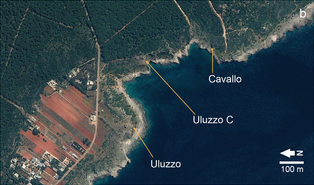Uluzzian



The Uluzzian Culture is a transitional archaeological culture between the Middle Paleolithic and the Upper Paleolithic, found in Italy and Greece.
A team led by archaeological scientist Katerina Douka has dated the Uluzzian as lasting from shortly before 45,000 to around 39,500 years before present (BP), at a similar date or slightly earlier than the Campanian Ignimbrite eruption.[1]
Geographical extent: In Italy: Apulia (the Grotta del Cavallo and the Uluzzo cave), Basilicata, Campania, Calabria, Tuscany, and Fumane (the northernmost point).[2] Outside of Italy, only in Argolis, Greece (the cave of Klissoura).[3]
Discovery
[edit]
Excavations by 1963 Arturo Palma di Cesnola of the Grotta del Cavallo ("Cave of the Horse") in southern Italy uncovered the first remains later called "Uluzzian".[4] The cave is on the Salento peninsula in Apulia, overlooking the Gulf of Taranto. The only human remains were two deciduous teeth (Cavallo B and Cavallo C) from the Uluzzian deposit of Grotta del Cavallo identified as human by (Benazzi et al., 2011).[5] These teeth, dated to 43,000–45,000 BP, are the oldest currently-known remains of modern humans in Europe.[5]
Middle to Upper Paleolithic transition
[edit]
The Uluzzian is one of several techno-complexes considered to be "transitional assemblages": Uluzzian, Châtelperronian, Szeletian, and Lincombian-Ranisian-Jerzmanowician.[6]
Culture
[edit]The Uluzzians made and used beads from shells of marine molluscs such as scaphopods, snails (Columbella rustica, Cyclope neritea), and other species.[1]
See also
[edit]References
[edit]- ^ a b Douka, Katerina; Higham, Thomas FG; Wood, Rachel; Boscato, Paolo (2014). "On the chronology of the Uluzzian". Journal of Human Evolution. 68: 1–13. doi:10.1016/j.jhevol.2013.12.007. PMID 24513033.(registration required)
- ^ Peresani, M., 2012. Fifty thousand years of flint knapping and tool shaping across the Mousterian and Uluzzian sequence of Fumane cave. Quaternary International 247, 125–150
- ^ "Klissoura cave" often appears in the literature, but the archaeologists themselves use the spelling "Klisoura" or the phrase "Cave 1 in Klisoura Gorge (Western Peloponnese)". Koumouzelis, M., Ginter, B., Koz1owski, J.K., Pawlikowski, M., Bar-Yosef, O., Albert, R.M., Litynska-Zajac, M., Stworzewicz, E., Wojtal, P., Lipecki, G., Tomek, T., Bochenski, Z.M., Pazdur, A., 2001. The early Upper Palaeolithic in Greece: the excavations in Klisoura cave. J. Archaeol. Sci. 28, 515–539.
- ^ Palma di Cesnola, Arturo (1964). "Seconda campagna di scavo nella grotta del Cavallo". Riv. Sci. Preist.: 23–39.
- ^ a b Benazzi, Stefano; Katerina, Douka; Fornai, Cinzia; Bauer, Catherine C. (2011). "Early dispersal of modern humans in Europe and implications for Neanderthal behaviour". Nature. 479 (7374): 525–528. Bibcode:2011Natur.479..525B. doi:10.1038/nature10617. PMID 22048311. S2CID 205226924. Retrieved April 26, 2020.
- ^ Hublin, J-J. (2015). "The modern human colonization of western Eurasia: when and where?". Quaternary Sci. Rev. 118: 194–210. Bibcode:2015QSRv..118..194H. doi:10.1016/j.quascirev.2014.08.011. hdl:11858/00-001M-0000-0024-11F6-F.
